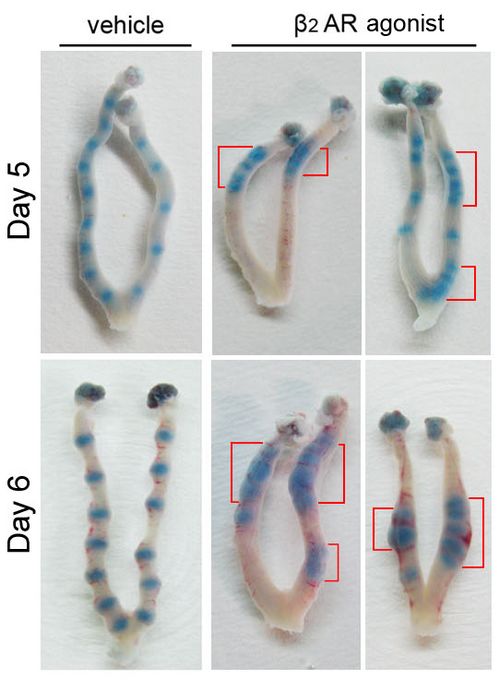Pregnancy loss is a common and painful condition for gestational women, accounting for 25-40% of total pregnancy, having become a serious social-medical issue worldwide. Animal studies and clinical investigations have indicated that the cause of many mid-term miscarriage/abnormal pregnancy has been seeded very early during the onset of embryo implantation. Epidemiological study also showed that maternal stress at early pregnancy is strongly associated with various complications during ongoing gestation. However, whether and how the process of embryo implantation is affected by environmental factors such as stress induced sympathetic activation remained elusive.
Considering the mammalian uterus is an organ with extensive sympathetic innervations, the research group leads by Prof. Enkui Duan at Institute of Zoology, Chinese Academy of Sciences hypothesized that it is possible that around the time of embryo implantation, stress-induced sympathetic activation may directly affect embryo-maternal interactions through adrenergic receptors, therefore affecting the quality of ongoing pregnancy.
By using mouse model, the research group found an unexpected, transient effect of β2-Adrenoceptor (β2-AR) activation (Day4 postcoitus) in disrupting embryo spacing at implantation (without changing implantation timing), leading to substantially increased mid-term pregnancy loss. In vitro and in vivo studies demonstrated that the transient β2-AR activation abolished normal preimplantation uterine contractility, without adversely affecting blastocyst quality. The contractility inhibition is mediated by activation of cAMP-PKA pathway and accompanied with specific downregulation of lpa3, a gene previously found to be critical for uterine contraction and embryo spacing. These results recapitulated the concept that “on-site” intrauterine embryo location mediated by concerted uterine contraction is crucial for successful ongoing pregnancy.
In human pregnancy, the process of intrauterine embryo location (usually at the uterine fundus) shares similar essence in mouse as conducted by well concerted uterine contraction. Abnormal embryo implantation at unfavorable intrauterine sites is prone to mid-term miscarriage or other pregnancy complications such as placenta praevia. It is an open but intriguing possibility that maternal stress at time of embryo transfer and/or implantation may cause similar sympathetic activation of uterine adrenergic receptors in human, resulting in suboptimal embryo location and pregnancy complications.
Notably, in this research, the authors also found that both pharmacological and genetic silencing of β2-AR are similarly efficient in reversing the adverse effect of abnormal β2-AR activation, providing β2-AR as a potential target in manipulating related uterine complications during human pregnancy.
This research has been published in Journal of Biological Chemistry(JBC)
Qi Chen1, Ying Zhang1 (1equal contribution), Hongying Peng, Li Lei, Haibin Kuang, Li Zhang, Lina Ning, Yujing Cao and Enkui Duan* Transient β2-Adrenoceptor activation confers pregnancy loss by disrupting embryo spacing at implantation. J Biol Chem. 2011 Feb 11;286(6):4349-56.
Original site: http://www.jbc.org/content/286/6/4349.long
This research was supported by "the National Basic Research Program of China", "the CAS knowledge Innovation Program" and "National Natural Science Foundation"

Figure.1 Blue dye reaction shows implantation sites in Day5 and Day6 pregnancy mice. The evenly spaced pattern of implantation sites was severely disrupted by transient β2-adrenoceptor activation at Day4, resulting in embryo crowding.

Figure.2 Histology of Day12 implantation sites showing normal (left, upper) and crowded implantation sites (left, lower), which were caused by abnormal maternal β2-adrenoreceptor activation before embryo attachment.
An example of triplets of (Day12) resulted from disrupted embryo spacing (right). The three embryos were crowed in one placenta. The embryo in the middle showed normal degree of development, the ones in the left and right showed different degrees of retarded embryo growth, the left one was tend to undergo resorption.


